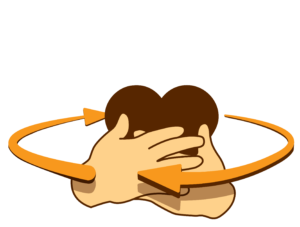 The following is an excerpt adapted from the chapter I wrote: “Compassion in Pain Care” in Yoga and Science in Pain Care: Treating the Person in Pain by Singing Dragon Publishers, p.250-51. (1):
The following is an excerpt adapted from the chapter I wrote: “Compassion in Pain Care” in Yoga and Science in Pain Care: Treating the Person in Pain by Singing Dragon Publishers, p.250-51. (1):
Here is a brief example using yoga practices to cultivate self-compassion in a moment of suffering or struggle, using Neff ’s three elements of self-compassion as a framework. (2)
*Peter is a person in pain who is feeling frustrated and angry because his pain flared up with what he describes as a minimal amount of yardwork that he feels he should be able to do easily and quickly. He feels guilty and thinks he is incompetent and expresses feeling “useless” because he cannot complete the “simple” project he promised his wife. He feels ashamed of not knowing how to manage his pain especially after all the time, effort and money he has spent on therapy.
- Mindfulness: Notice, acknowledge and accept that you are in a moment of suffering. Briefly perform a kosha scan where you intentionally notice the characteristics of all five koshas: notice the general state of your thoughts and emotions; become aware of the breath (notice the quality of the breath (smooth or rigid), the rate, depth, length of inhale/exhale, sound, sensation of breath at the nostrils including temperature of the breath); notice the general state of the body (physical sensations, temperature, tension); notice your overall energetic state; and finally, see if you can get a felt sense of connection to your “true self,” or a sense of your spirit. Notice any judgments or elaborative stories that the mind is creating. Watch and observe the characteristics within each kosha without trying to change anything. (3)
- Common humanity: Recognize that other people have shared this experience also. You are not alone. You may repeat this mantra in silence or out loud: Loka Samasta Sukhino Bhavantu. The words mean “May the whole world attain peace and harmony.” You are an important part of the world. The purpose of the chant is to create a greater capacity for love to all sentient beings and bring one into a harmonious connection to humanity. (4)
- Kindness: Take this opportunity to extend kindness towards yourself. You can practice karuna mudra, a yoga hand mudra conveying a gesture of compassion (5): Cup the hands and place them in an asymmetrical prayer position with pads of the left fingers touching the base of the right fingers. As you breathe in, imagine the breath is softening the area around your heart (front, sides and back) and repeat silently to yourself, “It’s OK.” As you breathe out, take your time and imagine letting go of any tension around the heart and repeat, “This is enough,” in a tone that is patient, soothing and forgiving. Repeat this for a few slow breaths and stop when you feel ready. You can choose a different mantra or affirmation that provides you with a sense of kindness and love towards yourself.
In summary, there is value in practicing self-compassion, with preliminary research supporting positive effects for people living in pain. I propose that self-compassion practices have a promising role to play in providing novel, safe and effective complementary pain reduction and management strategies as part of a biopsychosocial approach to pain care.
More about this chapter:
This chapter, Compassion in Pain Care, explores in-depth interpretations of compassion and the science surrounding compassion. It focuses on the value and importance of compassion in pain care, which consists of compassion for the patient by the health practitioner and self-compassion in both the patient and the practitioner. The context for compassion and its relationships to core yoga philosophical principles and practices are described and ways of cultivating compassion in pain care are outlined. Without compassion for the patient, we cannot form an effective therapeutic alliance/relationship. And without practicing self-compassion, it is difficult to continue helping people with this complex phenomenon of changing pain.
Thanks to Swami Lisa Pearson for providing inspiration to this practice and chapter.
* Patient’s name has been changed to protect confidentiality.
For more details on the book Yoga and Science in Pain Care: Treating the Person in Pain, co-edited and co-authored by Neil Pearson, Shelly Prosko and Marlsya Sullivan with chapter contributors: Joletta Belton, Steffany Moonaz, Matthew J Taylor, Matt Erb, Lori Rubenstein Fazzio, Tracey Sondik, Michael Lee, Antonio Sausys, Neil Pearson, Shelly Prosko, Marlysa Sullivan, visit HERE.
For a deeper dive into this topic, watch the webinar replay of my chapter Compassion in Pain Care from our Yoga and Science in Pain Care Book Club Webinar Series HERE
To learn more and access the video series Self-Compassion in Pain Care series: Body-Mind-Breath Practices for People in Pain, visit:
Use code selfcompassion25 to receive 25% off at checkout.
1) Prosko, S. (2019) “Compassion in Pain Care.” In: Pearson, N., Prosko, S. and Sullivan, M. (Eds). Yoga and Science in Pain Care: Treating the Person in Pain. London, UK: Singing Dragon Publishers. 235-256.
2) Neff, K. D. (2003) “Self-compassion: An alternative conceptualization of a healthy attitude toward oneself.” Self and Identity 2, 85–102.
3) Pearson, N. (n.d.) Breathing Techniques for People in Pain. [Audio CD] Accessed on 14/12/18 at https://paincareu.com/shop/page/2.
4) Kriyananda, G. (1997–2009) Oral Teachings 1997–2009.
5) Le Page, J. and Le Page, L. (2013) Mudras for Healing and Transformation. Pennsauken, NJ: BookBaby.
6) Prosko, S. (2020) Guided Self-Compassion Meditations with Shelly Prosko. Vimeo
7) Prosko, S. (2020) Compassion and Self-Care Content and Resources from Shelly.




